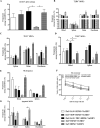The Combined Escherichia coli Nissle 1917 and Tryptophan Treatment Modulates Immune and Metabolome Responses to Human Rotavirus Infection in a Human Infant Fecal Microbiota-Transplanted Malnourished Gnotobiotic Pig Model
- PMID: 36073800
- PMCID: PMC9599269
- DOI: 10.1128/msphere.00270-22
The Combined Escherichia coli Nissle 1917 and Tryptophan Treatment Modulates Immune and Metabolome Responses to Human Rotavirus Infection in a Human Infant Fecal Microbiota-Transplanted Malnourished Gnotobiotic Pig Model
Abstract
Human rotavirus (HRV) is a major cause of childhood diarrhea in developing countries where widespread malnutrition contributes to the decreased oral vaccine efficacy and increased prevalence of other enteric infections, which are major concerns for global health. Neonatal gnotobiotic (Gn) piglets closely resemble human infants in their anatomy, physiology, and outbred status, providing a unique model to investigate malnutrition, supplementations, and HRV infection. To understand the molecular signatures associated with immune enhancement and reduced diarrheal severity by Escherichia coli Nissle 1917 (EcN) and tryptophan (TRP), immunological responses and global nontargeted metabolomics and lipidomics approaches were investigated on the plasma and fecal contents of malnourished pigs transplanted with human infant fecal microbiota and infected with virulent (Vir) HRV. Overall, EcN + TRP combined (rather than individual supplement action) promoted greater and balanced immunoregulatory/immunostimulatory responses associated with greater protection against HRV infection and disease in malnourished humanized piglets. Moreover, EcN + TRP treatment upregulated the production of several metabolites with immunoregulatory/immunostimulatory properties: amino acids (N-acetylserotonin, methylacetoacetyl-CoA), lipids (gamma-butyrobetaine, eicosanoids, cholesterol-sulfate, sphinganine/phytosphingosine, leukotriene), organic compound (biliverdin), benzenoids (gentisic acid, aminobenzoic acid), and nucleotides (hypoxathine/inosine/xanthine, cytidine-5'-monophosphate). Additionally, the levels of several proinflammatory metabolites of organic compounds (adenosylhomocysteine, phenylacetylglycine, urobilinogen/coproporphyrinogen) and amino acid (phenylalanine) were reduced following EcN + TRP treatment. These results suggest that the EcN + TRP effects on reducing HRV diarrhea in neonatal Gn pigs were at least in part due to altered metabolites, those involved in lipid, amino acid, benzenoids, organic compounds, and nucleotide metabolism. Identification of these important mechanisms of EcN/TRP prevention of HRV diarrhea provides novel targets for therapeutics development. IMPORTANCE Human rotavirus (HRV) is the most common cause of viral gastroenteritis in children, especially in developing countries, where the efficacy of oral HRV vaccines is reduced. Escherichia coli Nissle 1917 (EcN) is used to treat enteric infections and ulcerative colitis while tryptophan (TRP) is a biomarker of malnutrition, and its supplementation can alleviate intestinal inflammation and normalize intestinal microbiota in malnourished hosts. Supplementation of EcN + TRP to malnourished humanized gnotobiotic piglets enhanced immune responses and resulted in greater protection against HRV infection and diarrhea. Moreover, EcN + TRP supplementation increased the levels of immunoregulatory/immunostimulatory metabolites while decreasing the production of proinflammatory metabolites in plasma and fecal samples. Profiling of immunoregulatory and proinflammatory biomarkers associated with HRV perturbations will aid in the identification of treatments against HRV and other enteric diseases in malnourished children.
Keywords: Escherichia coli Nissle 1917; human rotavirus infection; lipidomics; malnutrition; metabolomics; neonatal gnotobiotic pigs; tryptophan.
Conflict of interest statement
The authors declare no conflict of interest.
Figures






Similar articles
-
Escherichia coli Nissle 1917 Enhances Innate and Adaptive Immune Responses in a Ciprofloxacin-Treated Defined-Microbiota Piglet Model of Human Rotavirus Infection.mSphere. 2021 Mar 31;6(2):e00074-21. doi: 10.1128/mSphere.00074-21. mSphere. 2021. PMID: 33789939 Free PMC article.
-
Escherichia coli Nissle 1917 administered as a dextranomar microsphere biofilm enhances immune responses against human rotavirus in a neonatal malnourished pig model colonized with human infant fecal microbiota.PLoS One. 2021 Feb 16;16(2):e0246193. doi: 10.1371/journal.pone.0246193. eCollection 2021. PLoS One. 2021. PMID: 33592026 Free PMC article.
-
Malnutrition Decreases Antibody Secreting Cell Numbers Induced by an Oral Attenuated Human Rotavirus Vaccine in a Human Infant Fecal Microbiota Transplanted Gnotobiotic Pig Model.Front Immunol. 2020 Feb 14;11:196. doi: 10.3389/fimmu.2020.00196. eCollection 2020. Front Immunol. 2020. PMID: 32117313 Free PMC article.
-
Induction of mucosal immune responses and protection against enteric viruses: rotavirus infection of gnotobiotic pigs as a model.Vet Immunol Immunopathol. 2002 Sep 10;87(3-4):147-60. doi: 10.1016/s0165-2427(02)00046-6. Vet Immunol Immunopathol. 2002. PMID: 12072229 Free PMC article. Review.
-
The Complex Interactions Between Rotavirus and the Gut Microbiota.Front Cell Infect Microbiol. 2021 Jan 8;10:586751. doi: 10.3389/fcimb.2020.586751. eCollection 2020. Front Cell Infect Microbiol. 2021. PMID: 33489932 Free PMC article. Review.
Cited by
-
Intestinal tryptophan metabolism in disease prevention and swine production.Anim Nutr. 2023 Aug 19;15:364-374. doi: 10.1016/j.aninu.2023.08.002. eCollection 2023 Dec. Anim Nutr. 2023. PMID: 38058568 Free PMC article. Review.
-
The protective role of prebiotics and probiotics on diarrhea and gut damage in the rotavirus-infected piglets.J Anim Sci Biotechnol. 2024 May 3;15(1):61. doi: 10.1186/s40104-024-01018-3. J Anim Sci Biotechnol. 2024. PMID: 38698473 Free PMC article. Review.
-
Microbiota-Derived Extracellular Vesicles as a Postbiotic Strategy to Alleviate Diarrhea and Enhance Immunity in Rotavirus-Infected Neonatal Rats.Int J Mol Sci. 2024 Jan 18;25(2):1184. doi: 10.3390/ijms25021184. Int J Mol Sci. 2024. PMID: 38256253 Free PMC article.
-
The Effect of Maternal Probiotic or Synbiotic Supplementation on Sow and Offspring Gastrointestinal Microbiota, Health, and Performance.Animals (Basel). 2023 Sep 22;13(19):2996. doi: 10.3390/ani13192996. Animals (Basel). 2023. PMID: 37835602 Free PMC article. Review.
References
-
- Tate JE, Burton AH, Boschi-Pinto C, Steele AD, Duque J, Parashar UD, WHO-coordinated Global Rotavirus Surveillance Network . 2012. 2008 estimate of worldwide rotavirus-associated mortality in children younger than 5 years before the introduction of universal rotavirus vaccination programmes: a systematic review and meta-analysis. Lancet Infect Dis 12:136–141. doi:10.1016/S1473-3099(11)70253-5. - DOI - PubMed
Publication types
MeSH terms
Substances
Grants and funding
LinkOut - more resources
Full Text Sources
Medical
